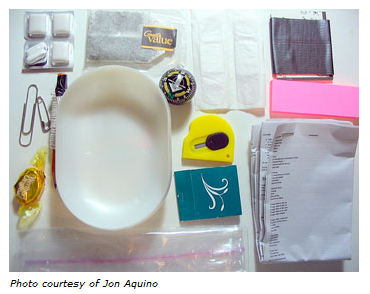Disaster Survival Kit
A catastrophic event could happen as you are reading this. Having a disaster survival kit readily available at a moment's notice may mean the difference between life and death for you and your family.
Whether the disaster involves a tornado, earthquake, hurricane, food shortage or even war, being self-sufficient and prepared to capably manage the loss of electricity, gas, access to fresh water and shelter will greatly reduce the risk of needlessly suffering in the aftermath of your own apocalypse.
Mini Survival Kits
|
Emergency mini survival kits and auto survival kits are meant to provide you with basic necessities for up to three days. This type of disaster survival kit is kept in cars, boats or taken along when camping or hiking. |
 |
Kept in containers that are small enough to fit into a pant or jacket pockets, these pocket survival kits contain items such as:
- Waterproof matches/lighter
- Small mirror or survival whistle for signaling purposes
- Candle
- Fishing line and hook
- Water purification tablets
- Small compass
- Hard candy or bouillon cubes.
Survival Kit in a Can
You can survive in desert or arctic conditions with the survival items included in this can, sometimes shaped like a sardine can. Conveniently compact, airtight and easily carried, a survival kit in a can contains any or all of the following items:
- Compass
- Waterproof matches
- Fishing line/hook
- Bouillon cube
- Tea bag
- Sugar packet
- Razor blade
- Signaling mirror
- Band aids
Winter Survival Kits
These survival kits specifically contain items necessary to survive cold and snowy conditions, such as encountered during a mountain-hiking trip. Winter survival kits are useful for times when blizzards occur and power outages are widespread and lengthy as well. A survival kit checklist should include:
- High-calorie meal bars, each containing 400 calories
- Water purification tablets (one tablet will purify about one quart of water)
- Meals packaged in heat-friendly pouches that can withstand fire
- Waterproof matches
- Emergency sleeping bags, thin but insulated
- Portable cooking stove
- Steel utensils and cups
- Long-burning candles
- Multi-function knife
- Collapsible tent
Survival Food Kits
Survival food kits can be packed to last one person three days, seven days or longer. Freeze-dried foods that are made edible by adding water are the best kind of food to pack in these kits. High calorie food of 2000 calories or more and high protein survival bars are also good items for a survival kit. Other items include water purification tablets, sugar packets, candles and plastic utensils.
Bug Out Bag (BOB), Go Bag and Grab & Go Bag
This type of survival kit is packed into a survival backpack and kept handy in case of an emergency. This survival bag, also called a "Get Out of Dodge Bag," was originally a 72-hour survival kit, but some people pack their BOB for longer emergencies. A grab & go bag is intended for serious emergencies that require everyone to leave the area as soon as possible.
For disasters that present long-term issues which society must handle possibly without assistance from the government, creating a disaster survival kit is a proactive strategy. A BOB contains certain supplies that may not be needed during short-term disasters, such as a pot for disinfecting water, rubber gas masks and duct tape and plastic.
Earthquake Survival Kits
The risk of serious injury is high in disasters such as earthquakes and tornadoes. Having the proper medical supplies available is vital to effectively treating cuts, gashes and broken bones. An exhaustive earthquake disaster survival kit should have the following:
- Band aids, all sizes
- Antiseptic/antibiotic/burn relief spray/ointment
- Gauze
- Alcohol/hydrogen peroxide
- Cold/hot packs
- Eye drops
- Extra strength ibuprofen or acetaminophen
- Sinus medication
- Antacid tablets
- Splint/stretch bandage to set broken bones
- Tweezers and scissors
- Benadryl for allergic reactions
- Q-tips
Always have a disaster survival kit available and fully supplied with items that will assist you in surviving any kind of disaster. Periodically check and update it with new and more conducive supplies, which can facilitate your survival in any emergency.
Different Types of Survival Kits
Return from Disaster Survival Kit back to Index





New! Comments
Have your say about what you just read! Leave me a comment in the box below.